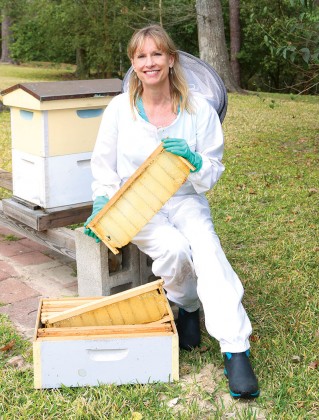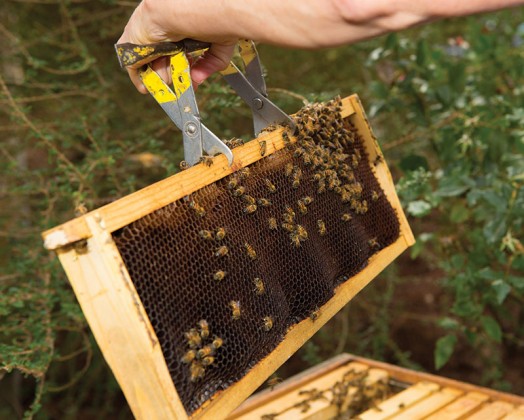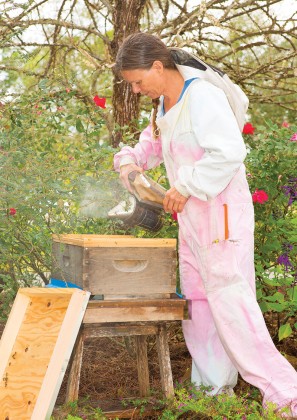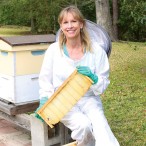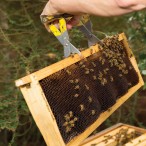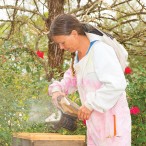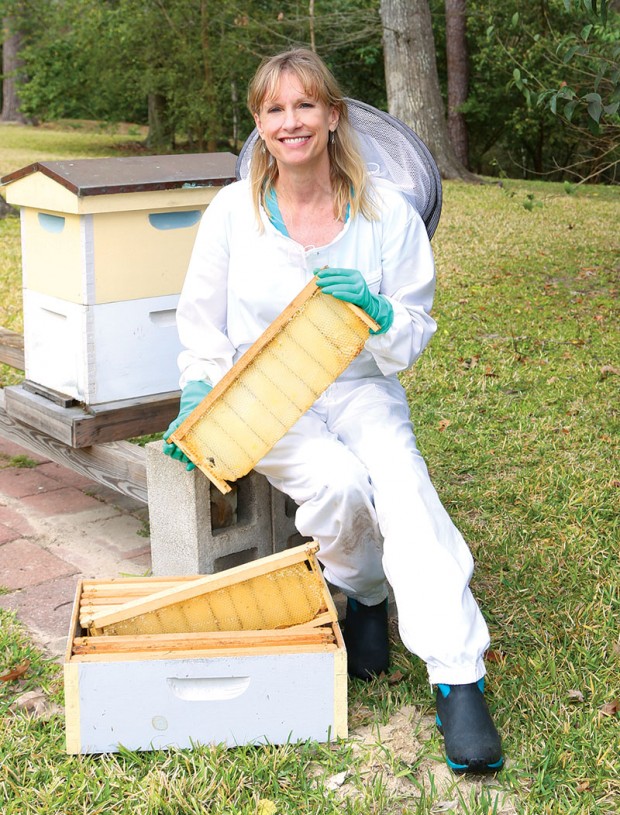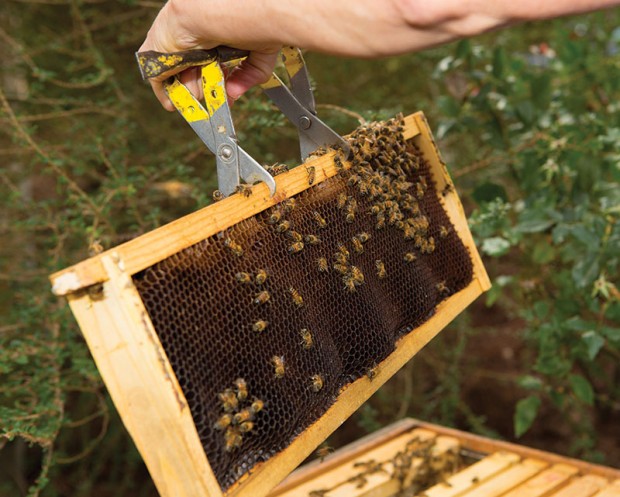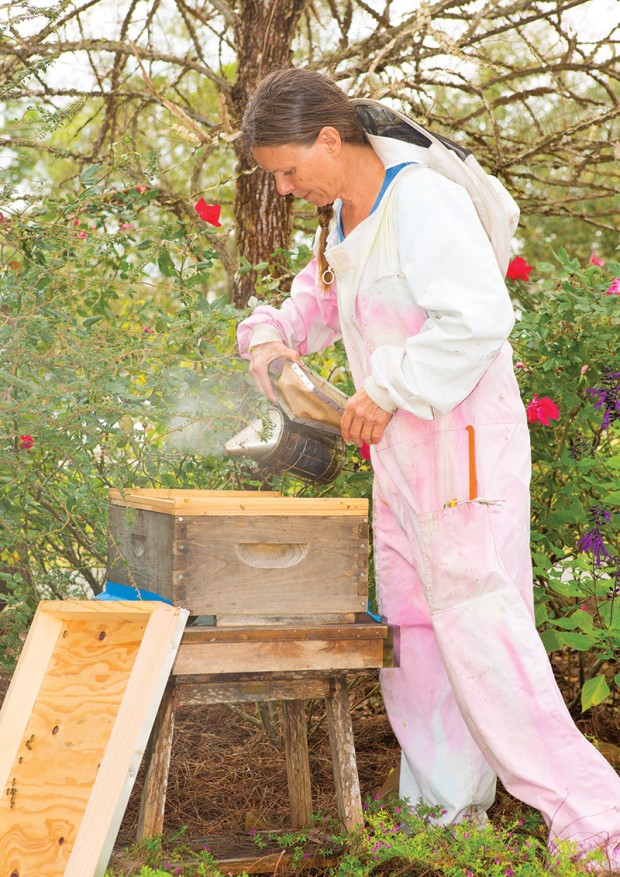The Bee's Knees
Backyard beekeepers have it sweet

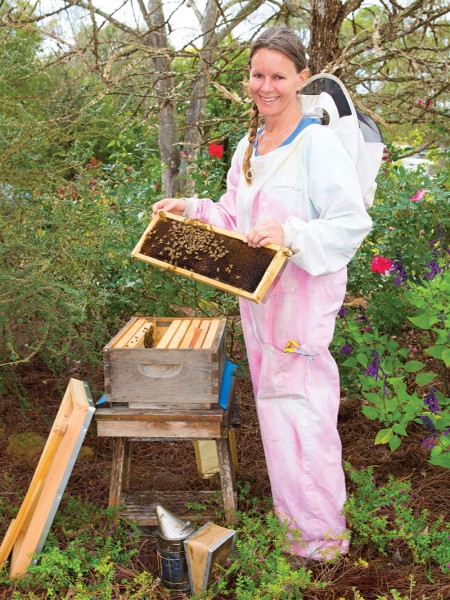
Shelley Rice, who’s studying to become a master beekeeper, is known around town as “The Bee Lady.” (Photo: lawellphoto.com)
When Shelley Rice read the first page of The Secret Life of Bees 14 years ago, she had no idea that the book by Sue Monk Kidd would fundamentally change her life. Although the coming-of-age novel moved her, it was the factual aspects of tending to bees that held her spellbound.
“I read the part about beekeeping,” recalls Rice, “and then I read and re-read it. God put that book in my life.”
With four kids and an ailing mother-in-law to take care of, it took the Bellaire resident six more years before she enrolled in a Leisure Learning Unlimited class about beekeeping. During those years, Rice daydreamed about bees. “Before then, I thought that beekeeping was something that people did in the country. But I did exactly what the teacher told me to do: I ordered my bees, ordered equipment, and I built my hives over my children’s Spring Break. Then, eight years ago, I loaded up all my kids in the car and we drove out to Navasota to pick up the bees.”
Today, Rice is now known around town as “The Bee Lady.” She is studying to become a master beekeeper and is two years into a five-year Texas Master Beekeeper Program at Texas A&M University. She teaches for the Central Texas Beekeeping Association and has a business removing bees and maintaining hives for people at their homes and public places such as The Last Organic Outpost and Discovery Green. As a volunteer, Rice lectures about bees and has helped programs, including the Lamar High School FFA, start hives.
She’s not the only urban beekeeper around.
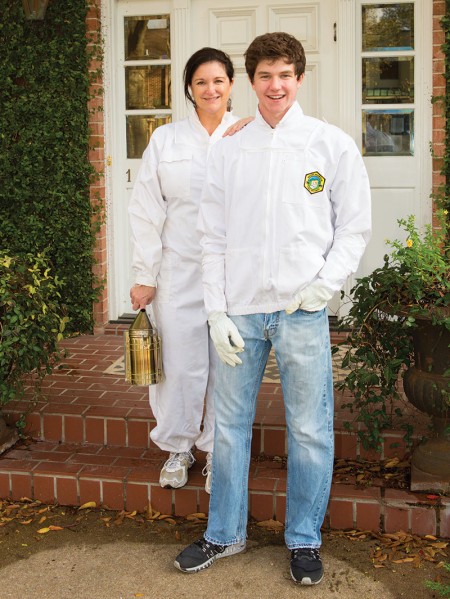
Lea Weingarten started beekeeping to help her son, Matthew, combat allergies. Now it’s become a hobby. (Photo: lawellphoto.com)
Southampton resident Lea Weingarten started beekeeping to help her youngest son, Matthew, combat allergies. “I had no interest in putting him permanently on allergy medication,” says Weingarten, principal of Weingarten Art Group. “Hearing that local honey – truly local, as within a three-mile radius of your home – is effective against allergies, I turned to a close friend who is a beekeeper.”
That was seven years ago, and she says the process not only helped Matthew, now a junior at St. John’s School, but it started a sweet hobby. “After my first harvest, my son began taking a tablespoon of honey a day,” recalls Weingarten, who says the allergies stopped. “This result continued for about four months, and then he developed allergies again. I realized that I had not harvested in some time so I did it again and once he had the newer honey, the allergies disappeared permanently.”
Matthew says he is not sure if the honey treatment was placebo or reality, but he is glad to be rid of allergies. “And,” he says, “I love having a never-ending supply of honey. And having the hive has made me become much more aware of the dying-bee population that I now recognize as a big problem.”
A recent study by the Intergovernmental Science-Policy Platform on Biodiversity and Ecosystem Services, as reported in The New York Times, says 20,000 species of wild bees and other pollinators globally are at risk of extinction because of pesticide use, fewer wildflower crops, parasites and pathogens. And, if the bees are at risk, so are the fruits, vegetables, nuts and flowering plants that depend on the bees.
Kathleen Dawson is a River Oaks-area resident who has been a beekeeper with husband Bo since 2008. "Bees are gentle animals who want to fulfill their duty to the queen and colony. People should understand that their best course of action is to leave the bees alone. Rogue bee colonies are best handled by experienced bee wranglers who will remove and transplant the colony to a hive managed by a willing beekeeper." Dawson advises others to make sure that they, as well as their exterminators and landscape workers, are not using pesticides harmful to pollinators. And add plants, such as basil, salvia and Texas lantana, that attract bees, she says.
Dawson says BeeWeavers Apiaries in Navasota is where many Houstonians buy their supplies. Beehives generally are wooden boxes with vertical frames that fit into slats on the inside, with an opening at the bottom where bees travel in and out.
Weingarten says Matthew and older son Jeffrey, now a sophomore at Dartmouth College, both help her with the bees. Jeffrey designed the logo with the name “Lea’s Bees” for the labels on her jars of honey, which she gives as gifts to friends.
Weingarten has learned that the phrase “Queen Bee” is a real thing. “The power of the queen is absolute – truly,” she says. “She controls every aspect of the hive by releasing pheromones which instruct the colony what to do and when, and their teamwork is extraordinary.” One time, she says, the queen in her hive was laying eggs, which requires the temperature inside to be 93-95 degrees. “I remember one very, very hot day when I looked out at the hive, there was a tight row of bees hanging upside down along the narrow entrances. They were furiously fanning the hive to promote air circulation – air conditioning completely powered by bees! A worker bee will fan until her wings are shredded, and she can no longer fly for the sake of the hive.”
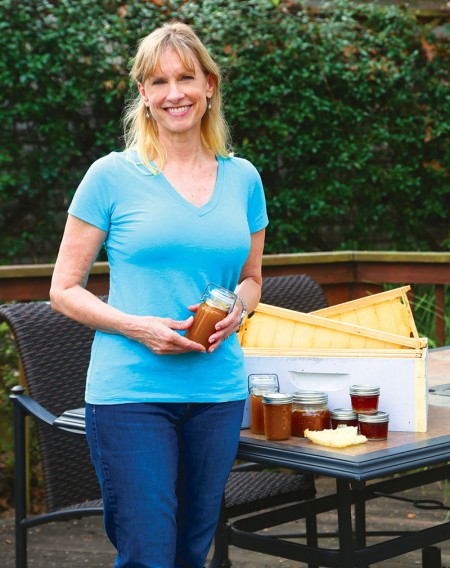
Karen Garcia harvested this honey from her beehive. She enjoys giving jars of her “Karen’s Honey” to family and friends as gifts. (Photo: lawellphoto.com)
Memorial resident Karen Garcia began beekeeping five years ago to help her apple, peach and citrus trees bear fruit. Karen and attorney-husband Roland had watched the number of bees dwindle. “If you don’t have bees, you don’t have fruit,” sums up Garcia, who turned to Rice to help her set up and start her hives. “Everything we eat is dependent on the bees.”
“Now, my trees are covered in bees all the time,” says Garcia, a technology consultant. And the proof is in the fruit – and the honey. “When the citrus trees are in bloom, my citrus honey is light and watery,” she says. “When not in bloom, the honey is wildflower honey and is darker and heavier in taste.” Garcia bottles up her honey in jars, labeled “Karen’s Honey,” and shares her bounty.
Although Garcia wears a bee suit to work with her bees, she has recently gotten into a prickly situation: She found out she is allergic to bee stings. A year ago, Garcia took off her bee suit and discovered one bee had flown into her hat and got tangled in her hair. While trying to remove the bee, Garcia got stung on her head. “All of a sudden, my hands started breaking out in hives,” she recalls. Now, she is taking allergy shots to prevent future reactions.
Two years ago, after a lifelong fascination with gardening, River Oaks resident Kate Gibson bought her first hive box and parts. Her son Wheeler hammered it all together. “Our hive sits right next to our window in the sunroom so you can sit and watch the bees,” says Gibson, an associate broker with Republic Ranches. “And we do sit and watch them for hours. There are certain bees that guard the entrance and sniff every bee that comes in. There are cleaner bees that haul out dead bees and then there are bees that bring in the pollen — they have big yellow balls on their back legs!”
Beekeeping has become a family affair, with attorney-husband Steve and their three children, Caroline, Carson and Wheeler. “The kids were a little skeptical but once I put them in a beekeeping suit, they were all in, and now the bees are a part of the family.” She says tending bees takes little time, as long as the bees have flowers and a water source nearby. “Our first year we did feed them a mixture of sugar water but have not since then. We keep an eye on them to make sure they are busy, but I call it benevolent neglect because you don’t have to do too much for them.”
Gibson also added 80 hives at their farm in Hempstead, which has lemon, lime, orange, grapefruit, avocado and fig trees. “Bees can increase your crop output four times,” she says. “The Hempstead honey tastes a little smokier because the bees feed off of various grasses and some alfalfa from our neighbor farms. But our in-town honey tastes distinctly of roses, as our neighbors have some amazing rose gardens nearby.” Playing off of the nickname “Gibby” that Kate calls her husband, Gibson’s jars, often gifted, are labeled “GibBee Honey.”
Memorial resident Adam Weinstein turned to Rice last year to help the Houston Congregation for Reform Judaism with a hive to commemorate Rosh Hashanah – the Jewish New Year that is celebrated with apples and honey. “I viewed the HCRJ hive as Tikkun Olam – to start the hive and be considered a mitzvah by helping repopulate the world of bees, to pollinate the flowers in our synagogue,” says Weinstein, a physician. “And, in return, the bees would make honey, and we could celebrate the New Year.”
Weinstein and Rice tended the hive and then brought all the frames to the synagogue – there, teams of children and adults worked together to spin, strain, bottle and label the honey, which was then sold to the community members to celebrate.
The taste of honey and the world of bees is, indeed, say the beekeepers, sweet.
For more on beekeeping:
The Houston Beekeepers Association
Harris County Beekeepers Association
Shelley Rice, “The Bee Lady,” bee removal, educational programming, bee education. Email: [email protected]
Read writer Jennifer Oakley's personal bee story.
Bees from A to Z
Apiary = A bee yard.
Apiarist = A beekeeper.
Apiculture = The science and art of raising honey bees.
Bee jacket = A white jacket, usually with a zip on veil and elastic at the sleeves and waist, worn as protection when working bees.
Bee suit = A pair of white coveralls made for beekeepers to protect them from stings and keep their clothes clean. Most come with zip-on veils.
Bee tree = A hollow tree occupied by a colony of bees.
Beehive = A box with movable frames, used for housing a colony of bees
Beekeeper = One who keeps bees. An apiarist.
Beeswax = A substance that is secreted by bees by special glands on the underside of the abdomen, deposited as thin scales, and used after mastication and mixture with the secretion of the salivary glands for constructing the honeycomb. Beeswax melts at approximately 145°F (63°C).
Bottling tank = A food-grade tank holding five or more gallons of honey and equipped with a honey gate to fill honey jars.
Bottom bar = The horizontal piece of the frame that is on the bottom of the frame.
Bottom board = The floor of a bee hive.
Brood = Immature bees not yet emerged from their cells; in other words, egg, larvae or pupae.
Brood chamber = The part of the hive in which the brood is reared; may include one or more hive bodies and the combs within. Sometimes used to refer to a deep box as these are commonly used for brood.
Candy plug = A fondant-type candy placed in one end of a queen cage to delay her release.
Cappings = The thin wax covering over honey; once cut off of extracting frames.
Cell = The hexagonal compartment of a honeycomb.
Colony = The aggregate of worker bees, drones, queen and developing brood living together as a family unit in a hive or other dwelling.
Comb = The wax portion of a colony in which eggs are laid and honey and pollen are stored shaped like hexagons.
Drone = The male honeybee which comes from an unfertilized egg (and is therefore haploid) laid by a queen or less commonly, a laying worker.
Eggs = The first phase in the bee life cycle, usually laid by the queen, is the cylindrical egg 1/16 inch (1.6 mm) long; it is enclosed with a flexible shell or chorion. It resembles a small grain of rice.
Flight path = Usually refers to the direction bees fly leaving their colony; if obstructed, may cause bees to accidentally collide with the person obstructing and eventually become aggravated.
Frame = A rectangular structure of wood designed to hold honeycomb, consisting of a top bar, two end bars, and a bottom bar; usually spaced a bee-space apart in the super.
Honey bee = The common name for Apis mellifera.
Pollen = The dust-like male reproductive cells (gametophytes) of flowers, formed in the anthers, and important as a protein source for bees; pollen is essential for bees to rear brood.
Queen = A fully developed female bee responsible for all the egg laying of a colony.
Queen cage = A special cage in which queens are shipped and/or introduced to a colony, usually with 4 to 7 young workers called attendants, and usually a candy plug.
Queen cage candy = Candy made by kneading powdered sugar with invert sugar syrup until it forms a stiff dough; used as food in queen cages.
Raw honey = Honey that has not been finely filtered or heated.
Scout bees = Worker bees searching for a new source of pollen, nectar, propolis, water, or a new home for a swarm of bees.
Super = A box with frames in which bees store honey; usually placed above the brood nest.
Telescopic cover = A cover with a rim that hangs down all the way around it usually used with a inner cover under it.
Uncapping knife = A knife used to shave off the cappings of sealed honey prior to extraction; hot water, steam or electricity can heat the knives.
Uncapping tank = A container over which frames of honey are uncapped; usually strains out the honey which is then collected.
Veil = A protective netting that covers the face and neck; allows ventilation, easy movement and good vision while protecting the primary targets of guard bees.
Worker bees = Infertile female bee whose reproductive organs are only partially developed, responsible for carrying out all the routine of the colony.
Want more buzz like this? Sign up for our Morning Buzz emails.
To leave a comment, please log in or create an account with The Buzz Magazines, Disqus, Facebook, or Twitter. Or you may post as a guest.


